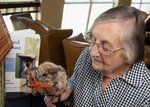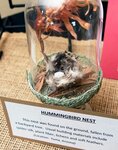

Some people collect stamps or baseball cards, but not many can say that they’ve had a collection of more than 200 bird nests.
But Sharon Jessup can.
A resident of Lakestone Terrace Senior Living, Jessup’s fascination with birds and bird nests began about 40 years ago when she lived in Panama with her husband during his military career.
“We ran into bird nests in the outdoors that were just incredible,” she said. “I became fascinated by the many strange and interesting homes built by birds.”
Jessup, 86, moved 23 times in 21 years during her husband’s career, living in Alaska, Massachusetts, Virginia, California, Alabama, Washington, Oregon, Idaho and a short time in New York before settling down in Yuma, Arizona, during retirement.
It was during her retirement that she opened a floral, craft and gift shop dedicated to making gift items of nature that were shipped to retail stores all over the United States. For 15 years, individuals crafted in their homes and were paid by the piece. Jessup said at one point, 49 sales representatives contributed products sold in the shop.
“Craft classes were given one night a week,” she said. “We displayed, identified and sold cones and pods. I was a guest speaker on the naturals for many clubs, organizations and school classes. A lot of natural items were on display and customers began bringing unique birds’ nests for display. This added another dimension.”
Jessup had always had a fascination with nature, trees and pods, but the addition of the birds’ nests in her shop fueled her interest in birds and the like, leading her to start collecting their nests.
“I did programs for kids and programs for adults. I just had a fascination and put them where they were on display many times. It just kind of mushroomed. I didn't even intend to gather bird nests, but it happened,” she said.
It’s actually illegal to collect bird nests, but Jessup received a permit from Arizona Game and Fish allowing her to collect the nests.
Over the years, Jessup’s collection grew until one day, she realized she had more than 200 nests.
TYPES OF NESTS
She had several nests in her collection that birds had constructed using unique and odd items, like packing materials, feathers, string, mistletoe and alpaca wool. One nest was even formed around a Bud Light can.
Jessup nicknamed one the “Girl Scout nest” because it was constructed out of yarn and craft material.
“It was evidently left at the end of a big Girl Scout conclave in the desert one weekend,” she said. “I was part of staff. We had 1,000 girls and everything was picked up well. There wasn't anything left, except next year when we came back, this nest was on the ground and we knew that we didn't quite pick up everything.”
Nests were also found in odd places, such as her son’s workshop, and an outhouse. Her most “famous” nest was one that was found on the back of an Army tank.
“The ingenuity of birds and what they made their nests of to me was all incredible. The nests I have, many of them I cannot identify, but they're made in such creative ways that they're special and fun,” Jessup said.
When she left Yuma to move to Lakestone Terrace to be closer to her daughter, she sent almost her entire collection to the Western Foundation of Vertebrate Zoology in California (located just outside Los Angeles). The WFVZ is a nonprofit corporation that specializes in collecting eggs and nests from around the world. The collection is among the largest in the world and its mission is to contribute to the conservation of the world’s wild bird species through accessibility of the collection and the availability of data to researchers, students and the public.
In addition to the nests, other items Jessup donated were life-size wings of the eagle and condor (made of fabric) and a variety of bird egg replicas including the condor, eagle and hummingbird.
Jessup kept a few nests from her collection, which are currently being displayed in the library at Lakestone Terrace through Father's Day.
“I knew that I was going to be moving and I had to find a place that would care for and take care of these nests. I kept a few, and this ended up to be the few I kept. How they ever ended up in a retirement center, I have no idea, but it just always fascinated me,” she said, with a chuckle.
Nests weren’t the only thing that fascinated Jessup though. She was also interested in birdhouses or “bird hotels.”
When she still lived in Yuma, her garden club began making birdhouses, but they found their supplies in a rather peculiar place — the junkyard.
“Our whole garden club would go out every spring to a dump,” Jessup said, with a smile. “We would carry pails with us and then we would bring all this junk back and that's what we would decorate our birdhouses with. Well, pretty soon we ran out of dumps and there was nowhere else to go, so we started going to thrift shops and patio sales."
BYE, BYE BANDSAW
The birdhouses were all built by members of the garden club — and with the help of Jessup’s special bandsaw.
“The bandsaw was in our shop and we used it all the time, and when we left the shop and sold everything my husband wanted to sell the bandsaw and I said, ‘No way, the bandsaw is mine,’” she said, chuckling. “Before coming to Lakeside Terrace, I asked if I could bring my bandsaw. Would you believe that the answer was 'No?’”
She said the worst part though, was having to put her bandsaw up for sale.
“Two women came and bought it. Have you ever seen a grown woman cry because her bandsaw was sold?” she said, laughing.
Although Jessup’s bird nest collection has dwindled, she still managed to find one more nest just in time for her display in the library — a woodpecker’s nest made in a dead saguaro cactus, which is rare for this area.
Originally, Jessup had three of those nests, but because they can only be found in the desert, she decided to donate them to the WFVZ in California.
“I wanted to keep one of those so bad but to me, they’re so precious and so difficult to find, so I finally sent them off,” she said.
Recently however, while Jessup was shopping in Cresson, she came across another nest at the One-Eyed Rooster — but it was listed as a hornet’s nest.
“I knew what it was, but it certainly wasn’t any hornet’s nest,” she said, with a chuckle.
Jessup hoped that her bird nest display brought as much joy to the residents as it has to her over the last several years.
She added, “It’s just fun. I love the creativity of the builders and the stories that are connected with the nests.”